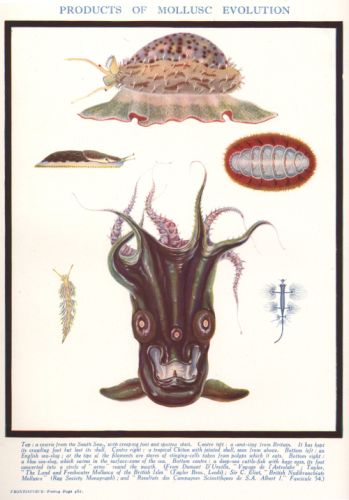
| Palaeos |  |
Mollusca |
| Metazoa | Mollusca |
| Page Back | Unit Up: Metazoa | Unit Home | Mollusca Glossary | Page Next |
| Unit Back: Annelida |
Clade Down: Aculifera Conchifera |
Mollusca Dendrogram | Mollusca References | Unit Next: Platyzoa |
|
Abbreviated Dendrogram
SPIRALIA |--BRACHIOPODA `--+--ANNELIDA | `--MOLLUSCA |--Aculifera | |==Mattheviidae | |--Aplacophora | `-- Polyplacophora `--Conchifera |==Tryblidiida (Monoplacophora) | `--Cephalopoda `==Helcionelloida |==Rostroconchia | `-- Scaphopoda |--Bivalvia `--Gastropoda |
Unit Contents
|
Page Contents
|
Taxa on This Page
 image from More images of devilish aquatic creatures |
The Mollusks are a large and diverse group of soft-bodied unsegmented animals. Nearly 130,000 recent species are known, and some 35,000 fossil species. They include many familiar animals, like snails, clams, squid, octopi, etc, as well as others not so well known. They range in size from microscopic forms to the giant squid (Architeuthis), and have a long and venerable history appearing during earliest Cambrian time, if not before.
All mollusks possess some or all of the following characteristics:
Although not all mollusks share all these characteristics, generally all mollusks have at least some of them.
Despite sharing these common features, the mollusks are an incredibly diverse group. The following diagram shows the major classes, which as can be seen are all based on variation in this same body plan.

This diagram presents a stylized relationship between the different Molluscan groups, with all evolving from a "hypothetical ancestral mollusk". It is now known that molluscan phylogeny is a lot more complex than this.
As one of the most successful forms of animal life, the mollusks have conquered almost every habitat and exist in all the oceans (from shallow tidal pools to the deepest trenches), in fresh water, and on land. The only environment they cannot cope with are very dry regions, as their moist skin is easily desiccated. Even so, the greatest diversity of mollusks species is to be found in marine environments
When Linnaeus was formulating his system of binomial nomenclature the mollusks were grouped (along with most invertebrates) under vermes, worms. The name Mollusca (from the Latin mollis "soft"), was first used by the great French zoologist Cuvier in 1798 to refer to cephalopods like squids and cuttlefish. It was later extended to include other organisms of this group, such as snails and bivalves.
The mollusks first appeared during the earliest Cambrian (Tommotian), at the very start of radiation of coelomate animals. The 35,000 fossil species that are known are without doubt only a small fraction of those that have ever lived. As the Cambrian period progressed, many types appeared that soon died out. Although previously included among the conventional classes of mollusks it is increasingly argued that these represent distinct classes, early experiments in molluscan evolution, or transition forms. However, the exact number of extinct classes remains debatable
By the Ordovician period the three main classes - Gastropoda, Bivalvia, and Cephalopoda - had increased greatly in number and diversity. This was a period of major evolutionary diversity for the phylum, and they became common in most marine ecosystems
The Devonian saw bivalves invade freshwater, and the first land snails appeared during the Carboniferous. During the Devonian also, the ammoniod took over from the nautiloids as the dominant cephalopod group, and these creatures continued to flourish throughout the entire Mesozoic, living alongside species of bivalves and gastropods not very different to modern forms. (Oysters for example were common during the Jurassic and Cretaceous, while scallops date back to the Paleozoic). By mid Cretaceous most mollusks, like most invertebrates and fish, were essentially like modern forms, except for the Cephalopods which were still represented largely by the Mesozoic ammonites and belemnites. The ammonites were decimated by the K-T extinction event, as were the reef-building rudist bivalves (although these were on the decline for some time), but the coleoids (soft-bodied squids, octopi etc) continued to evolve quite happily.
Traditionally seven classes are recognized: Aplacophora (primitive worm-like shell-less forms), Polyplacophora (chitons, these were at one tile included with the Aplacophora), Monoplacophora (primitive ancestral forms), Gastropoda (snails and slugs), Bivalvia (clams, mussels, oysters, etc), Scaphopoda (tooth and tusk shells), and Cephalopoda (squids, octopus, nautilus, cuttlefish), of which only Gastropoda, Bivalvia, and Cephalopoda have large numbers of species and a strong fossil record. However it is becoming increasingly recognized that there were more groups that have since died out.
 image from More images of devilish aquatic creatures |
Mollusca Linnaeus 1758
Range: Fr ECambrian
Phylogeny: Spiralia (=Lophotrochozoa) : Brachiopoda + (Annelida + * : Aculifera + Conchifera) (see also Phylogeny page)
Characters: shell-secreting mantle (in primitive shell-less forms secretes instead calcareous spicules,), a single muscular foot (sometimes highly modified), radula (rasping file-like organ, secondarily lost in bivalves and some Solenogastres), unique nervous system with two main pairs of nerve cords, and pectinate gills. (Nielsen (2001, via Jack R. Holt Systematic Biology)
Description: The second largest phylumj in the animal kingdom (surpassed only by the arthropods), a highly diverse phylum that includes both familiar animals such as snails and slugs, periwinkles, whelks, limpets, mussels, oysters, scallops, clams, squid, octopus, cuttlefish and many other forms. Although many are distinguished by a hard external shell, others such as slugs and octopus lack any trace of shell.
Links: Phylum Mollusca - a good brief introduction to the Mollusks; The Living World of Molluscs - another very good intro, a bit more detailed; Mollusca Tree of Life project; Malacology - from the Australian Museum On-line; Mollusca - a good introduction, from Biomedia (Glasgow University Zoology Museum); Index of Mollusks by Ralph Body - mostly still under construction, although the Aplacophora are well covered; The Classes of Phylum Mollusca - short overview of each of the extant classes; Phylum Mollusca Systema Naturae 2000 / Classification - ; LAB 3 Chapter 8: Phylum Molusca - some lecture notes and images.
| Page Back | Page Top | Unit Home | Page Next |
page uploaded 29 September 2002
page by M. Alan Kazlev 020929, checked ATW050731, last revised MAK120607 Creative Commons Attribution